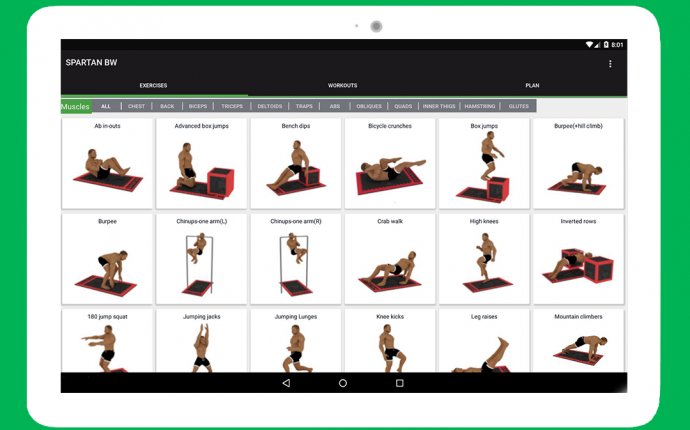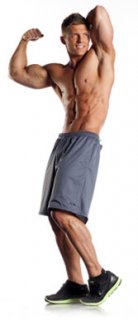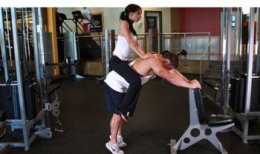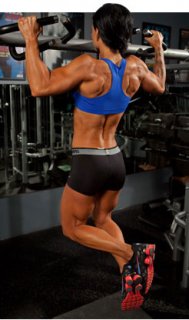
best exercises to build muscle without weights
 Why would anyone want to work out without weights? Everyone knows that using weights and machines is the fastest, most efficient way to gain size and strength. While this is true, there are many reasons why someone would want to—or even be forced to—train for a while without the benefit of using weights.
Why would anyone want to work out without weights? Everyone knows that using weights and machines is the fastest, most efficient way to gain size and strength. While this is true, there are many reasons why someone would want to—or even be forced to—train for a while without the benefit of using weights.
Someone working long hours trying to support his family may not have the time to get to a commercial gym, and may not have the extra space or money to set up a good home gym. Also, someone who has to travel quite often for business might prefer getting a good workout in his or her hotel room rather then wandering the streets of South America asking "Dónde está el gimnasio?"
Let's face it—there are times (vacations, etc.) when we can't easily get to a gym. There are also many trainees (beginners or athletes training for boxing, baseball or some other sport) who aren't trying to get a lot of muscular bulk but want the type of strength, endurance and definition that calisthenic exercise offers. These exercises can also be performed anytime, anywhere, and you can do them over your entire life to keep fit.
What Is The Best Way To Work Out Without Weights?
If for some reason you do workout without weights, what is the most efficient and result producing way to do it? You can use these exercises in many ways: To build muscle, to maintain muscle you already have, in combination with your weight training to add variety and a change of pace, as a warm-up or pump-up routine, to ease back into training after a layoff or injury, etc.
Very early in my training career, I started thinking about how to make calisthenics produce more results. The original reason was to help out one of my best friends at the time, who also happened to be the person who inspired me to start training by seeing the great progress he was making. Let's call him Joe, mostly because that was his name, I believe he prefers to be called Joseph these days, but back then he was still good old Joe.
 Anyway, one day Joe's father forbade him to work out with weights anymore. He gave Joe some reasons for this decision, but I think the real reason was that he didn't like the idea that his 15-year-old son was getting a little too big and strong to be easily controlled, and he'd better do something about it before he gets any bigger.
Anyway, one day Joe's father forbade him to work out with weights anymore. He gave Joe some reasons for this decision, but I think the real reason was that he didn't like the idea that his 15-year-old son was getting a little too big and strong to be easily controlled, and he'd better do something about it before he gets any bigger.
The funny part was that his father didn't object to him doing push-ups or other bodyweight exercises; only weight training was forbidden. I'm sure he figured that, at best, Joe would be able to maintain the muscle he had, but he wouldn't get any bigger. Joe was distraught by the situation, convinced that his muscles were doomed to waste away to nothing, but I was sure there was some way to make those exercises more intense and maybe even help him gain some size.
I came up with some ideas and tried to tell Joe about them, but he didn't seem too interested. His attitude was like "Hey, I know more about training then this guy, I'm the one who got him started. And besides, I don't have time to listen to this, I'm too busy feeling sorry for myself and performing satanic rituals to curse my dad."
Joe never used my ideas, but I did many times over the years, whenever I used calisthenics, and always got good results. I got even more ideas, a few years back, after reading the famous "Dynamic-Tension Course" by Charles Atlas.
 I found an old comic book, and decided to write to the address and see if the course was still available. Much to my delight, it was, and I ordered it. I ordered it mostly as a collector's piece and novelty item, like owning a part of American pop culture. Who could forget those great advertisements like "The insult that made a man out of "Mac." "Who else wants a He-Man body?" or "In just 7 days, I can make you a Man." I was also curious as to what was this dynamic-tension method exactly.
I found an old comic book, and decided to write to the address and see if the course was still available. Much to my delight, it was, and I ordered it. I ordered it mostly as a collector's piece and novelty item, like owning a part of American pop culture. Who could forget those great advertisements like "The insult that made a man out of "Mac." "Who else wants a He-Man body?" or "In just 7 days, I can make you a Man." I was also curious as to what was this dynamic-tension method exactly.
I have always believed that "only a fool thinks he knows everything and a wise man never stops learning, " so there was a possibility that I could find some good information in this "old, outdated course." I read the course and found it quite interesting. I was slightly disappointed to find out that dynamic tension is really just some calisthenics and some isometric exercises. And while I'm sure they would do a lot for 198-pound weaklings, what can they do for someone who's already fairly big and strong?
This got me thinking again about how these exercises could be made more intense. Since then, I've come up with a few more ideas, and now it's time to end the history lesson and share them with you.
100 Rep Sets
The first technique is to just do the exercises in the traditional manner. I know you can do 60, 80, even 100 reps, but that's the idea, to grind out as many reps as you can to build up your endurance and give your muscles a change of pace. And while this most likely won't give you any extra size right away, when you go back to weight training with heavy weights and lower reps you may be surprised that you are now gaining faster then before.
A few years ago, some top bodybuilders were talking about a technique they called "100s, " where they reduced the weight and did 100 reps on all their exercises. They claimed it brought about certain physiological changes that made the muscles more responsive to heavier training later on. It's worth a try, especially if you're going to be doing calisthenics anyway.
Flex Hard & Hold It
Here's another way to get more results from these exercises: Right after a set, flex the muscles just worked really hard, flex as hard as you can, and hold for at least a count of 10. Arnold talked extensively about "posing as exercise, " and the use of isotension. (Iso means equal, so isotension is simply contacting the muscle and holding it in the same place without no movement.)
He said that it really gives the body a more chiseled look, reaches areas that training misses, and will make muscular contractions while training more intense, and more isolated. These are all good reasons to try this technique.A better variation of this is to flex the muscles you are working first, get them good and tired, and then do the exercise, thus prefatiguing them. For example, flex the chest or triceps muscles as hard as you can, then immediately do a set of push-ups. Feels different, doesn't it? It's a lot harder and produces much better results.
Reduce Rest Time Between Sets
Another technique is to reduce the rest time between exercises. Let's say you start with 60 seconds, then after a while cut it down to 45, and then 30, then 15. How about no rest between sets, a whole cycle of calisthenics all done nonstop. That makes it way more intense.








